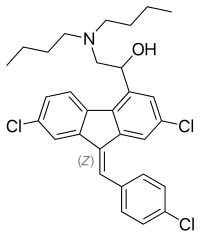 | |
| Clinical data | |
|---|---|
| AHFS/Drugs.com | International Drug Names |
| MedlinePlus | a609024 |
| Routes of administration | Oral |
| ATC code |
|
| Legal status | |
| Legal status |
|
| Identifiers | |
IUPAC name
| |
| CAS Number | |
| PubChem CID | |
| DrugBank | |
| ChemSpider | |
| UNII | |
| KEGG | |
| ChEBI | |
| ChEMBL | |
| CompTox Dashboard (EPA) | |
| ECHA InfoCard | 100.133.797 |
| Chemical and physical data | |
| Formula | C30H32Cl3NO |
| Molar mass | 528.94 g·mol |
| 3D model (JSmol) | |
| Melting point | 130 to 132 °C (266 to 270 °F) |
SMILES
| |
InChI
| |
| (what is this?) (verify) | |
Lumefantrine (or benflumetol) is an antimalarial drug. It is only used in combination with artemether. The term "co-artemether" is sometimes used to describe this combination. Lumefantrine has a much longer half-life compared to artemether, and is therefore thought to clear any residual parasites that remain after combination treatment.
Lumefantrine, along with pyronaridine and naphthoquine, were synthesized during the Chinese Project 523 antimalaria drug research effort initiated in 1967; these compounds are all used in combination antimalaria therapies.
See also
References
- Toovey S, Jamieson A, Nettleton G (August 2003). "Successful co-artemether (artemether-lumefantrine) clearance of falciparum malaria in a patient with severe cholera in Mozambique". Travel Medicine and Infectious Disease. 1 (3): 177–179. doi:10.1016/j.tmaid.2003.09.002. PMID 17291911.
- White NJ, van Vugt M, Ezzet F (August 1999). "Clinical pharmacokinetics and pharmacodynamics and pharmacodynamics of artemether-lumefantrine". Clinical Pharmacokinetics. 37 (2): 105–125. doi:10.2165/00003088-199937020-00002. PMID 10496300. S2CID 72714420.
- Cui L, Su XZ (October 2009). "Discovery, mechanisms of action and combination therapy of artemisinin". Expert Review of Anti-Infective Therapy. 7 (8): 999–1013. doi:10.1586/eri.09.68. PMC 2778258. PMID 19803708.
- Benjamin J, Moore B, Lee ST, Senn M, Griffin S, Lautu D, et al. (May 2012). "Artemisinin-naphthoquine combination therapy for uncomplicated pediatric malaria: a tolerability, safety, and preliminary efficacy study". Antimicrobial Agents and Chemotherapy. 56 (5): 2465–2471. doi:10.1128/AAC.06248-11. PMC 3346652. PMID 22330921.
- Laman M, Moore BR, Benjamin JM, Yadi G, Bona C, Warrel J, et al. (December 2014). "Artemisinin-naphthoquine versus artemether-lumefantrine for uncomplicated malaria in Papua New Guinean children: an open-label randomized trial". PLOS Medicine. 11 (12): e1001773. doi:10.1371/journal.pmed.1001773. PMC 4280121. PMID 25549086.
| Antiparasitics – antiprotozoal agents – Chromalveolata antiparasitics (P01) | |||||||||||||||||||||||||||||||||||||||||||||||
|---|---|---|---|---|---|---|---|---|---|---|---|---|---|---|---|---|---|---|---|---|---|---|---|---|---|---|---|---|---|---|---|---|---|---|---|---|---|---|---|---|---|---|---|---|---|---|---|
| Alveo- late |
| ||||||||||||||||||||||||||||||||||||||||||||||
| Stramen- opile | |||||||||||||||||||||||||||||||||||||||||||||||
| |||||||||||||||||||||||||||||||||||||||||||||||
This antiinfective drug article is a stub. You can help Misplaced Pages by expanding it. |